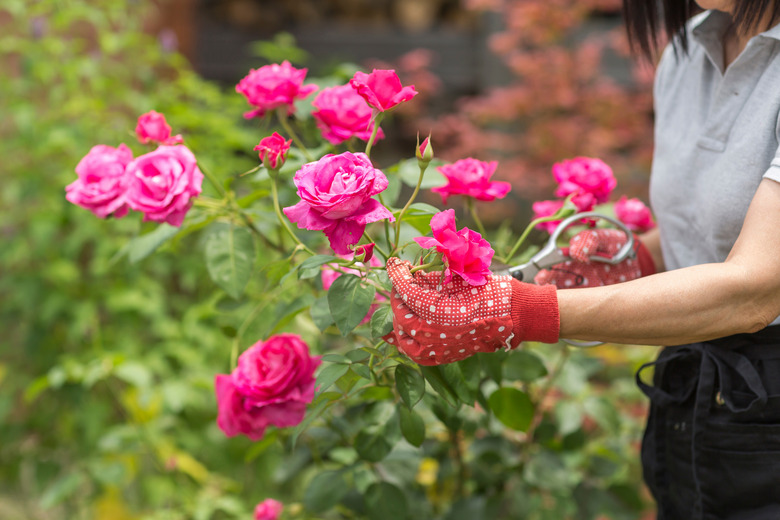How To Trim Rose Bushes Before Winter
How to prune roses before winter: Don't. As hardy as many rose (Rosa spp.) varieties are, they still need some time for fresh pruning cuts to harden off before the winter blasts come.
**But you may want to prune in the early fall to clean up the plants and neaten your garden.** Here's a briefer on when and how to prune your roses.
When to Prune Roses
Rose varieties differ widely in their pruning requirements depending on category and growing zones, but there are rules-of-thumb for when certain types of roses will benefit from pruning.
Tip
Roses vary widely in their growing zones, and if you are talking about the entire Rosa genus, the experts report that it grows in all USDA hardiness zones. So be sure to check with your local nursery or university extension office to determine the zone range for your rose, because that will help clarify winter care and pruning times.
Pruning Roses for Winter
To prepare your roses to overwinter nicely, **some experts recommend pruning about one-third of the bush at the end of the growing season, but no more than six weeks before your area's first frost.**
So if your area usually gets a frost or freeze by October 15, walk that back six weeks and perform your last rose pruning by September 1.
Pruning Roses According to Type
Different types of roses have different flowering patterns, which in turn impact when to prune them. You don't want to prune off wood that will be the primary source of future blooms.
Here's a simple guide on when to prune different types of roses:
Pruning Different Types of Roses
| Rose Category | Specific Type | Flowering Habit | Pruning Procedure |
| Shrub Roses | Huge array of roses that generally don't fit into other categories. Often called "landscape roses." | Repeat-flowering. Flowers on mature, non-woody stems. | Don't prune newly planted roses for the first two or three years. Then remove 1/3 of the oldest canes in spring. Identify 1/3 of the youngest canes. Remove the remaining canes. |
| Everblooming Roses | Hybrid teas (R. hybrida), floribundas (R. Floribunda Group), grandifloras (R. grandiflora), miniatures (R. chinensis minima) | Repeat-flowering. Flowers on new wood. | Prune hard in early spring: Prune off dead and small, weak canes. Retain 3 to 5 strong canes, spaced evenly. Prune back these canes, leaving 3 to 5 buds. |
| Old Garden Roses | Includes two primary types: once-blooming Damasks (Rosa × damascena), Alba (R. alba), Gallica (R. gallica and others) and repeat-blooming Bourbons (R. Bourbon Group), Hybrid Perpetuals (R. Perpetual Hybrids) and more). | Depends on class: Once-bloomers flower on old wood. Repeat-bloomers flower on both new and old wood. | **Once-bloomers: ** Prune after flowering, then prune only to thin or remove old wood. **Repeat-bloomers:** Prune before flowering. Maybe pruned harder than the once-blooming types. |
| Climbers and Ramblers | Multiple varieties exist, but ramblers are generally larger than climbers, with very vigorous canes. | Climbers are repeat-blooming. Ramblers are once-blooming. | Wait a few seasons before pruning to allow size to develop. **Climbers:** Prune in early spring, cutting back side shoots to just 3 to 6 inches to encourage more blooms. **Ramblers: **Prune right after flowering in early summer. Prune 1/3 of the oldest canes annually. |
Pruning Roses: the Basics
When you prune a rose, you have a few goals: 1) to remove damaged or dead wood or wood that is crossing; 2) to increase circulation to deter disease; and 3) to keep your rose bush from becoming a huge, tangled thicket. You also want to make sure that you encourage the growth of flowering wood. To summarize:
1. **Disinfect and sharpen your pruners:** Making clean cuts dissuades disease from entering the plant tissues. 2. **Cut at a 45° angle:** Slant down to ensure that water runs off the cut rather than settles on top of it. Make the cut about 1/4 inch above an outward-facing bud to avoid too much growth within the rose. 3. **Prune off thin, weak or dead canes:** Slice cleanly, again about 1/4 inch from the stem. Avoid cutting too close, so you don't damage the stem itself. 4. **For grafted roses,** **remove any sucker growth:** This sucker growth just sucks energy from the growth above the graft, the rose you actually want. To remove suckers, try to dig around in the dirt and find where they emerge from the root zone, and cut them off there. If, instead, you cut them off at the soil level, they are likely to just produce more suckers.
